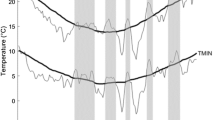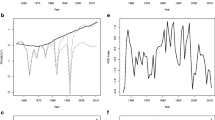Abstract
The El Niño Southern Oscillation (ENSO) is an ocean–atmosphere phenomenon involving sustained sea surface temperature fluctuations in the Pacific Ocean, causing disruptions in the behavior of the ocean and atmosphere. We develop a Markov-switching autoregressive model to describe the Southern Oscillation Index (SOI), a variable that explains ENSO, using two autoregressive processes to describe the time evolution of SOI, each of which associated with a specific phase of ENSO. The switching between these two models is governed by a discrete-time Markov chain, with time-varying transition probabilities. Then, we extend the model using sinusoidal functions to forecast future values of SOI. The results can be used as a decision-making tool in the process of risk mitigation against weather- and climate-related disasters.











Similar content being viewed by others
References
Ailliot P, Monbet V (2012) Markov-Switching autoregressive models for wind time series. Environ Model Softw 30:92–101
Box GEP, Jenkins GM (1976) Time series analysis. Forecasting and control, Holden Day
e Silva EGS, Legey L, e Silva EAS (2010) Forecasting oil price trends using wavelets and hidden Markov models. Energy Econ 32:1507–1519
Fallahi F, Rodriguez G (2014) Link between unemployment and crime in the US: a Markov-switching approach. Soc Sci Res 45:33–45
Filardo A (1994) Business-cycle phases and their transitional dynamics. J Bus Econ Stat 12:299–308
Guo H, Brooks R, Shami R (2010) Detecting hot and cold cycles using a Markov regime switching model—evidence from the Chinese A-share IPO market. Int Rev Econ Finance 19:196–210
Hamilton J (1989) A new approach to the economic analysis of nonstationary time series and the business cycle. Econometrica 57:357–384
Hansen (1982) Large sample properties of generalized method of moments estimators. Econometrica 50:1029–1054
Hansen BE (1992) The likelihood ratio test under non-standard conditions. J Appl Econom 7:S61–S82
IRI (2008) ENSO Basics, http://iri.columbia.edu/climate/ENSO/background/basics.htm, June 2008
Kulkarni MK, Revadekar JV, Varikoden H (2013) About the variability in thunderstorms and rainfall activity over India and its association with El Niño and La Niña. Nat Hazards 69:2005–2019
Li LP, Zhang KM, Luo T (2013) An analysis of the drought and flood hazard characteristics and risks during the pre-rainy season in South China. Nat Hazards 71:1195–1213
Liu W, Chyi Y (2006) A Markov regime-switching model for the semiconductor industry cycles. Econ Model 23:569–578
Meehl G (1990) Development of global coupled ocean–atmosphere general circulation models. Clim Dyn 5:19–33
Meehl G (2000) Trends in extreme weather and climate events: issues related to modeling extremes in projections of future climate change. Bull Am Meteorol Soc 81:427–436
NCDC (2013) Climate information, http://www.ncdc.noaa.gov/climate-information, August 2013
NOAA (2010) ENSO, http://www.oar.noaa.gov/k12/html/elnino2.htm, April 2010
Poveda G, Alvarez D, Rueda O (2010) Hydro-climatic variability over the Andes of Colombia associated with ENSO: a review of climatic processes and their impact on one of the Earth’s most important biodiversity hotspots. Clim Dyn 36:2233–2249
Ubilava D, Helmers G (2013) Forecasting ENSO with a smooth transition autoregressive model. Environ Model Softw 40:181–190
Walid C, Chaker A, Masood O, Fry J (2011) Stock market volatility and exchange rates in emerging countries: a Markov-state switching approach. Emerg Mark Rev 12:272–292
Yuan C (2011) Forecasting exchange rates: the multi-state Markov-switching model with smoothing. Int Rev Econ Finance 20:342–362
Zhou X, Tang Y, Deng Z (2009) Assimilation of historical SST data for long-term ENSO retrospective forecasts. Ocean Model 30:143–154
Zucchini W, McDonald I (2009) Hidden Markov models for time series: an introduction. Chapman Hall/CRC, Boca Raton
Author information
Authors and Affiliations
Corresponding author
Rights and permissions
About this article
Cite this article
Cárdenas-Gallo, I., Akhavan-Tabatabaei, R., Sánchez-Silva, M. et al. A Markov regime-switching framework to forecast El Niño Southern Oscillation patterns. Nat Hazards 81, 829–843 (2016). https://doi.org/10.1007/s11069-015-2106-y
Received:
Accepted:
Published:
Issue Date:
DOI: https://doi.org/10.1007/s11069-015-2106-y




